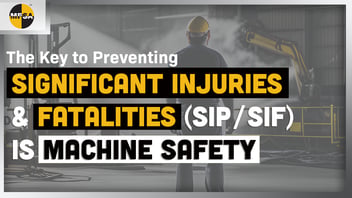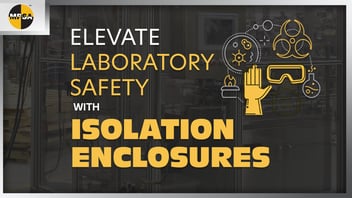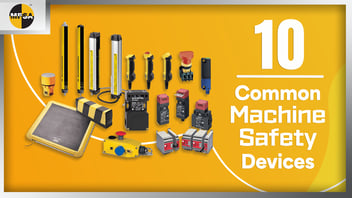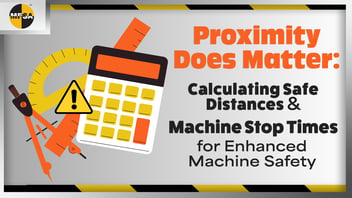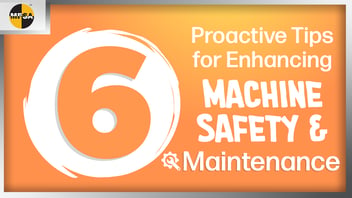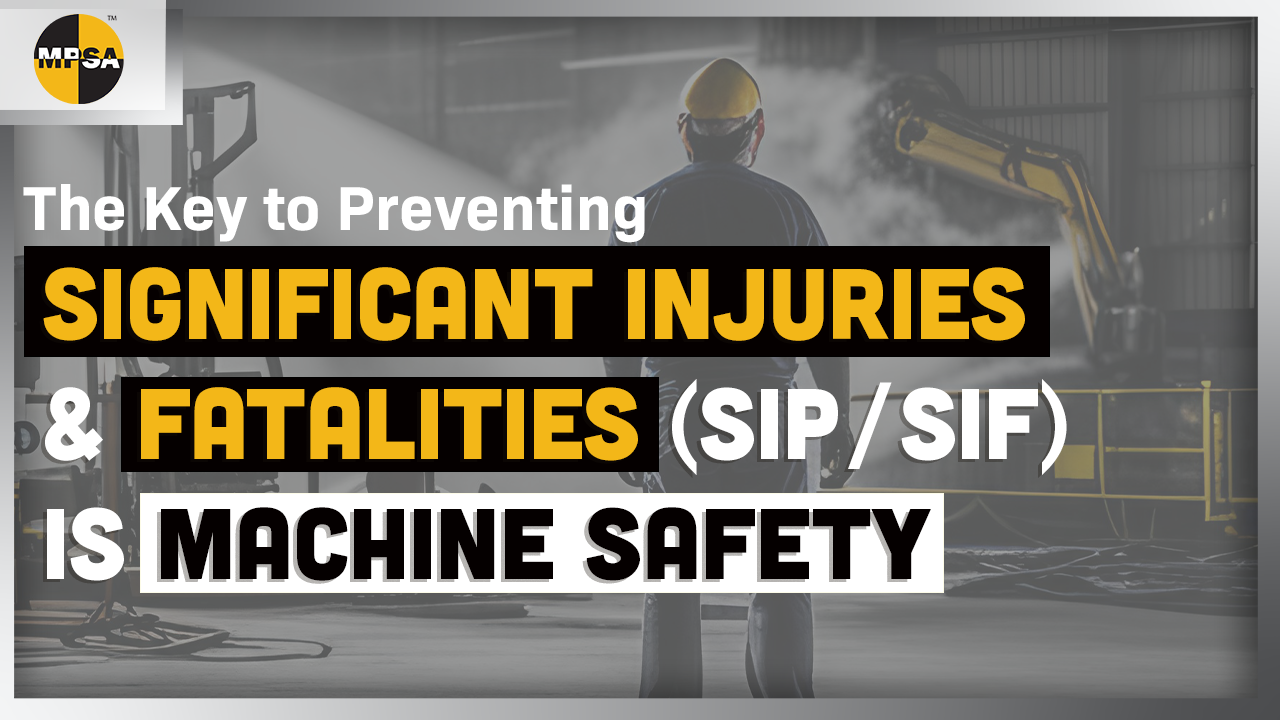
The Key to Preventing Significant Injuries and Fatalities (SIP/SIF) is Machine Safety

Posted By: David Kerr
December 7th, 2023
No matter the severity of the injury, whether it's a near miss, serious injury, or fatality, taking proactive measures can help prevent future SIF (Significant Injuries and Fatalities) incidents. However, neglecting to include machine safety for preventing SIF incidents will leave your program incomplete and leave your workers vulnerable to hidden dangers and potential fatalities in the workplace. In this blog, we'll learn how to implement a proactive approach to machine safety, including risk assessments and other activities to reduce the potential for serious, if not fatal, machine safety-related events.
Skip to a Section
What Do SIP & SIF Stand For? | Why Does Machine Safety Matter for SIP? | How Do You Prevent Serious Injuries and Fatiitlies? | What is the Scope of My Machinery? | The Bigger Picture | Key Takeaways | Expert Resources
What Do SIP and SIF Stand For?
![]() The following abbreviations describe workplace accident prevention efforts focused on preventing serious injuries or fatalities. Implementing a plan for preventing SIP/SIF incidents is crucial for creating a safe and healthy work environment.
The following abbreviations describe workplace accident prevention efforts focused on preventing serious injuries or fatalities. Implementing a plan for preventing SIP/SIF incidents is crucial for creating a safe and healthy work environment.
SIP = Significant Injury Prevention
SIF = Significant Injuries and Fatalities
SIP/SIF = life-threatening, life-changing, or life-ending injuries
When building a comprehensive SIP/SIF program, regardless of the terminology used within your organization, machine safety is an essential component.
Why Does Machine Safety Matter for Significant Injury Prevention (SIP)?
While companies may heavily invest in routine EHS (Environment, Health, and Safety) awareness, engagement, and training efforts, these actions may not effectively identify the less common or "hidden risks" that often occur when interacting with industrial machinery. You may ask, "But I haven't had any serious injuries or fatalities at my plant, so we are good, right?" The answer is, no!
Think of the ship as your EHS activities and awareness, and think of the lurking iceberg as the low-frequency, but catastrophic machine safety incidents that occur when hidden risks are not properly identified.
The failure of many organizations assumes that SIP/SIF program efforts only apply to construction or maintenance operations and do not realize their applicability to other machine operations. Machine operations should consider all types of automated and high-speed manufacturing, packaging, and material systems, including robotics in research, manufacturing, packaging, workshops, and logistics operations.
![]() Even if you don't typically perform hazardous construction or maintenance work, you may still have machines that present potential hazards. These machines include conveyor systems, packaging machines, and CNC machines. In such cases, SIP/SIF is an essential safety measure that can help prevent accidents and injuries.
Even if you don't typically perform hazardous construction or maintenance work, you may still have machines that present potential hazards. These machines include conveyor systems, packaging machines, and CNC machines. In such cases, SIP/SIF is an essential safety measure that can help prevent accidents and injuries.
How Do You Prevent Serious Injuries and Fatiitlies?
So, how does your organization effectively manage the risks associated with operating industry machinery? Here are some effective steps for SIF prevention:
A Comprehensive Review of the Machinery
![]() The most important step is for safety professionals to complete a comprehensive review of the machinery, inclusive of all forms of operation, maintenance, and repair. This generally means conducting a machine safety survey or, ideally, a risk assessment to identify all risks and hazards associated with various forms of machine use. Actually, OSHA requires a Hazard Analysis for industry machinery using any type of machine safety controls, other than fixed guarding.
The most important step is for safety professionals to complete a comprehensive review of the machinery, inclusive of all forms of operation, maintenance, and repair. This generally means conducting a machine safety survey or, ideally, a risk assessment to identify all risks and hazards associated with various forms of machine use. Actually, OSHA requires a Hazard Analysis for industry machinery using any type of machine safety controls, other than fixed guarding.
To comply with this requirement, completing the machine safety survey/risk assessment is your next step. Just one word of caution: EHS professionals are very accustomed to performing risk assessments for various EHS risks, but when machine safety is being considered, the risk assessment criteria must be specific to machine safety and align with one of the recognized machine safety industry standards.
Machine Risk Assessments
To get started with your risk assessments, you will need to identify and align the following resources:
What is the Scope of My Machinery?
-
Assemble a local team of stakeholders:
Bring relevant individuals from different departments or areas of expertise to collaborate on machine-safeguarding efforts. -
Define company requirements and regulatory standards that apply:
Establish the specific requirements and standards that need to be followed to ensure compliance with both internal company policies and external regulations. -
Collect the technical documentation for the machines in scope:
Gather all relevant technical documentation, including manuals, specifications, and operating procedures, for the machines that require safeguarding measures. -
Identify your hazard identification method:
Choose an appropriate method for identifying potential hazards associated with the machines in question, such as conducting a machine safety survey or performing a comprehensive machine safety risk assessment.
Need help identifying? Contact MPSA; one of our experts can answer all your machine safety questions. Unless companies are proactive and deliberately engaging machine operators, carefully analyzing near-miss or close-call data, and managing change and mechanical integrity efforts, machine safety risks and their consequences may remain “hidden“ within your organization.
The Bigger Picture
 Prioritizing machine safety in your SIP/SIF program creates a safer work environment, increasing overall success. It is crucial for employee well-being, productivity, and efficiency. A proper management plan prevents downtime and safeguards against serious injuries and fatalities.
Prioritizing machine safety in your SIP/SIF program creates a safer work environment, increasing overall success. It is crucial for employee well-being, productivity, and efficiency. A proper management plan prevents downtime and safeguards against serious injuries and fatalities.
Key Takeaways
![]() Machine safety is the key to fatality prevention and reducing an SIP/SIF incident in the workplace.
Machine safety is the key to fatality prevention and reducing an SIP/SIF incident in the workplace.
 SIP/SIF is the low-frequency but high-severity type of injury common with industrial machinery and often has “hidden hazards” until a machine safety survey or risk assessment is conducted.
SIP/SIF is the low-frequency but high-severity type of injury common with industrial machinery and often has “hidden hazards” until a machine safety survey or risk assessment is conducted. ![]()
Organizations must take proactive and deliberate steps to identify and manage the likelihood of a serious injury or fatality.
Resources from our Experts
Subscribe to our blog
Most Recent
Ensuring machine safety is a regulatory requirement and crucial to maintaining a safe and efficient working environment. The complexities of...
No matter the severity of the injury, whether it's a near miss, serious injury, or fatality, taking proactive measures can help prevent future SIF (...
It's that time of year when ghosts and goblins come out to play, and while we enjoy a good scare during the Halloween season, there's one thing that...
Safety must stand as an unwavering pillar in any laboratory setting, ensuring innovation thrives without compromising the well-being of those at the...
At your facilities, the utmost priority is the safety of your employees and the integrity of your operations. Every day, your machines are crucial in...
Ensuring the safety and well-being of employees operating industrial machinery requires a deliberate and well-designed approach. Applying “quick fixes
Did you know there's a crucial connection between machine safety maintenance and the well-being of your workers? It's true! And as technology...

The Trusted Turnkey Checklist: How to Find the Right Machine Safety Provider for Your Upgrade Project
Here at MPSA, we define turnkey machine safety solutions as designed, built, installed, validated, and ready to operate. But finding a trusted...




